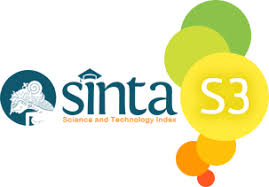Komunikasi Pemasaran Destinasi Cagar Budaya di Kabupaten Lumajang
 Abstract views: 807
,
Abstract views: 807
,
 PDF downloads: 1001
PDF downloads: 1001
Abstract
Tourism is recently becoming excellent attraction for Indonesia development. Lots of Indonesia region have striven to develop its tourism destination in attracting more tourist, including Lumajang regency as one of potential destinations with several kinds of tourism object in East Java. One of those is the cultural heritage. Besides, culture and natural tourism object are something may not be missed. From these phenomenon, the writer would like to have research on topic Marketing Communication Cultural Tourism Destination In Lumajang District. It is based on great potency of cultural heritage in Lumajang
In this research, the writer will apply qualitative method approach and integrated marketing communication theory. It is to understand the tourism marketing strategy of Lumajang cultural heritage. It is due to great potency of Archaeological sites in Lumajang which needs certain strategy in increasing the number of visitor.
Tourism and Cultural Department of Lumajang as the manager needs to compile innovative and creative steps in marketing communication implementation. Tourism and Cultural Department of Lumajang, in fact, has not maximumly implemented that marketing communication at all. For intense, it concerns marketing target and even positioning which is so limited. It seriously will make government need to plan innovative marketing communication design and message as creative as possible. Therefore, I may influence tourist to visit Lumajang regency more.
The results showed that the means of integrated marketing communication has not been applied as a whole so that required a very high commitment by the Government of Lumajang Regency, in this case the Department of Tourism and Culture of Lumajang Regency to apply it in an integrated manner in the years to come, in order to preserve the preservation Culture in Lumajang District
Keywords : Marketing Communication, Tourism Destination, Cultural Heritage
References
Ardial, Haji. (2014). Paradigma dan Model Penelitian Komunikasi. Jakarta: Bumi Aksara.
Ahmadi, Ruslan. (2016). Metodologi Penelitian Kualitatif, Yogyakarta: Ar-Ruzz Media
Bungin, Burhan. (2001). Metodologi Penelitian Kualitatif, Jakarta : Rajawali Pers.
------------------ (2007). Penelitian Kualitatif. Jakarta : Prenada
Media Group.
------------------ (2015). Komunikasi Pariwisata (Tourism Communication) Pemasaran dan Brand Destinasi, Jakarta : Kencana.
Ghozali, M.Dody. (2005). Communication Measurement, Konsep dan Aplikasi Pengukuran Kinerja Public Relations, Bandung : Simbiosa Ekatama Media.
Hasan, Ali. (2015). Tourism Marketing, Yogyakarta : CAPS (Center for Academic Publishing Service).
Moleong, J.Lexy. (2000). Metodologi Penelitian Kualitatif, Bandung : PT. Remaja Rosdakarya.
Mulyana, Deddy. (2001). Metodologi Penelitian Kualitatif Paradigma BaruIlmu Komunikasi dan Ilmu Sosial lainnya. Bandung : PT. Remaja Rosdakarya.
Priyadi, Dr. Unggul, M.Si. (2016). Pariwisata Syariah, Prospek dan Perkembangan, Yogyakarta : Unit Penerbit dan Percetakan Sekolah Tinggi Ilmu Manajemen YKPN.
Suartha, Dr. Nyoman, SH, M.Si, I Gusti Gede Purwa Sudartha, SE, MM. (2017) Industri Pariwisata Bali, Jakarta : PT. Raja Grafindo Persada.
Stephen W. Little.(2016). Teori komunikasi. Jakarta, Salemba Humanika
UNDANG-UNDANG Undang-Undang Nomor 11 Tahun 2010 Tentang Cagar Budaya
PERATURAN BUPATI Peraturan Bupati Lumajang Nomor 79 Tahun 2014 Tentang Destinasi wisata satu kecamatan satu desa wisata di Kabupaten Lumajang
Copyright (c) 2017 Jurnal Komunikasi Profesional

This work is licensed under a Creative Commons Attribution-ShareAlike 4.0 International License.

Jurnal Komunikasi Profesional is licensed under a Creative Commons Attribution-ShareAlike 4.0 International License.
1. Proposed Policy for Journals That Offer Open Access
Authors who publish with this journal agree to the following terms:
- Authors retain copyright and grant the journal right of first publication with the work simultaneously licensed under a Creative Commons Attribution License that allows others to share the work with an acknowledgment of the work's authorship and initial publication in this journal.
- Authors are able to enter into separate, additional contractual arrangements for the non-exclusive distribution of the journal's published version of the work (e.g., post it to an institutional repository or publish it in a book), with an acknowledgement of its initial publication in this journal.
- Authors are permitted and encouraged to post their work online (e.g., in institutional repositories or on their website) prior to and during the submission process, as it can lead to productive exchanges, as well as earlier and greater citation of published work (See The Effect of Open Access).
2. Proposed Policy for Journals That Offer Delayed Open Access
Authors who publish with this journal agree to the following terms:
- Authors retain copyright and grant the journal right of first publication, with the work [SPECIFY PERIOD OF TIME] after publication simultaneously licensed under a Creative Commons Attribution License that allows others to share the work with an acknowledgement of the work's authorship and initial publication in this journal.
- Authors are able to enter into separate, additional contractual arrangements for the non-exclusive distribution of the journal's published version of the work (e.g., post it to an institutional repository or publish it in a book), with an acknowledgement of its initial publication in this journal.
- Authors are permitted and encouraged to post their work online (e.g., in institutional repositories or on their website) prior to and during the submission process, as it can lead to productive exchanges, as well as earlier and greater citation of published work (See The Effect of Open Access).



